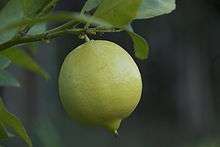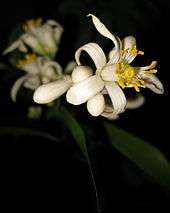Meyer lemon
| Meyer lemon Citrus × meyeri | |
|---|---|
 | |
| Meyer Lemon | |
| Scientific classification | |
| Kingdom: | Plantae |
| (unranked): | Angiosperms |
| (unranked): | Eudicots |
| (unranked): | Rosids |
| Order: | Sapindales |
| Family: | Rutaceae |
| Genus: | Citrus |
| Species: | C. × meyeri |
| Binomial name | |
| Citrus × meyeri | |
Citrus × meyeri, the Meyer lemon, is a hybrid citrus fruit native to China. It is a cross between a citron and a mandarin/pomelo hybrid distinct from the common or bitter oranges.[1]
Mature trees are around 6 to 10 ft (2 to 3 m) tall with dark green shiny leaves. Flowers are white with a purple base and fragrant. The fruit is rounder than a true lemon, deep yellow with a slight orange tint when ripe, and has a sweeter, less acidic flavor.
It was introduced to the United States in 1908 as S.P.I. #23028[2] by the agricultural explorer Frank Nicholas Meyer, an employee of the United States Department of Agriculture who collected a sample of the plant on a trip to China.[3]
The Meyer lemon is commonly grown in China in garden pots as an ornamental tree. It became popular as a food item in the United States after being rediscovered by chefs such as Alice Waters at Chez Panisse during the rise of California Cuisine starting in the 1970s.[4][5] Popularity further climbed when Martha Stewart began featuring them in her recipes.[3]
Description
Citrus × meyeri trees are around 6 to 10 ft (2 to 3 m) tall at maturity, though they can be pruned smaller. Their leaves are dark green and shiny. The flowers are white with a purple base and fragrant.[6]

The Meyer lemon fruit is yellow and rounder than a true lemon.[6] The skin is fragrant and thin, coloured a deep yellow with a slight orange tint when ripe. Meyer lemon fruits have a sweeter, less acidic flavour than the more common Lisbon or Eureka supermarket lemon varieties.[6] The pulp is a dark yellow and contains up to 10 seeds per fruit.
As the tree matures it will usually grow thorns or spines.
Cultivation

The Meyer lemons is popular as an ornamental plant for its compact size, hardiness and productivity. It is decorative and suitable for container growing. The tree is reasonably hardy and grows well in warm climates. It is fairly vigorous, with a plant grown from seed usually beginning to fruit in four years yielding thousands of lemons over its lifetime. While fruit is produced throughout the year, the majority of the crop is harvest-ready in winter.[7] Trees require adequate water, but less in the winter. For maximum yield, they should be fertilized during growing periods.
Improved Meyer

By the mid-1940s, the Meyer lemon had become widely grown in California. However, at that time it was discovered that a majority of the Meyer lemon trees being cloned were symptomless carriers of the Citrus tristeza virus, a virus which had killed millions of citrus trees all over the world and rendered other millions useless for production.[8] After this finding, most of the Meyer lemon trees in the United States were destroyed to save other citrus trees.
A virus-free selection was found in the 1950s[9] and was certified and released in 1975 by the University of California as the 'Improved Meyer lemon' — Citrus × meyeri 'Improved'.[10][11]
References
- ↑ Curk, Franck; Ollitrault, Frédérique; Garcia-Lor, Andres; Luro, François; Navarro, Luis; Ollitrault, Patrick (2016). "Phylogenetic origin of limes and lemons revealed by cytoplasmic and nuclear markers". Annals of Botany. 11: 565–583. doi:10.1093/aob/mcw005. PMC 4817432.
- ↑ "Lemon". Hort.purdue.edu. Retrieved 2014-06-09.
- 1 2 O'Hara, Julie (18 February 2009). "The Meyer Lemon: More Than A Pretty Face". National Public Radio. Retrieved 2009-02-20.
For more than a century, the Meyer lemon was known mostly for its looks. In its native China, it was primarily a decorative houseplant. The Meyer lemon might still be decorating homes today if it weren't for one man. In the early 1900s, the U.S. Department of Agriculture sent Frank N. Meyer, an agricultural explorer (yes, that was his actual job title) on several trips to Asia with the mission of collecting new plant species. Among more than 2,500 plants that he introduced to the U.S., the Meyer lemon was named in his honor. Sadly, Meyer would never live to see the success of his namesake. He died on an expedition near Shanghai in 1918.
- ↑ Lowry, Patricia (February 12, 2009). "When life hands you Meyer lemons, life is sweet". Pittsburgh Post-Gazette. Pittsburgh.
Meyer lemons are sweet, thin-skinned and famous for their ethereal perfume. Although common in California backyards, they are just beginning to be commercialized. Ask your friends or relatives in California to send you some," Alice Waters wrote in her Chez Panisse Cafe Cookbook in 1999. A decade later you don't have to beg, thanks in part to Waters' championing of the Meyer and to more growers entering commercial production.
- ↑ Slow Food USA. "Domestic Programs". Slow Food USA. Retrieved 2014-06-09.
- 1 2 3 Christman, Steve (10 February 2018). "1067 Citrus meyeri". Floridata. Retrieved 3 August 2018.
- ↑ "Citrus Variety Collection: Improved Meyer". University of California Riverside. 2002-05-28. Retrieved 2014-06-09.
- ↑ Lee, Richard F. (2015). "Chapter Five - Control of Virus Diseases of Citrus". Advances in Virus Research. 92: 143–173. Retrieved 3 August 2018.
- ↑ "Four Winds Growers: Meyer Lemon Origins". FourWindsGrowers.com. Archived from the original on 5 Oct 2010.
- ↑ Markoulakis, Sophia (May 2005). "Meyer Lemon Sweet Enough To Squeeze" (PDF). Master Gardener News - Amador County. University of California Cooperative Extension. p. 6. Archived from the original (PDF) on 7 March 2006.
- ↑ Reuther, Walter; Leon Dexter Batchelor; E. Clair Calavan; Herbert John Webber; Glenn E. Carman; Robert G Platt (June 1989). Citrus Industry: Crop Protection. University of California. p. 195. ISBN 0-931876-24-9.
External links
| Wikimedia Commons has media related to Citrus Meyeri group. |